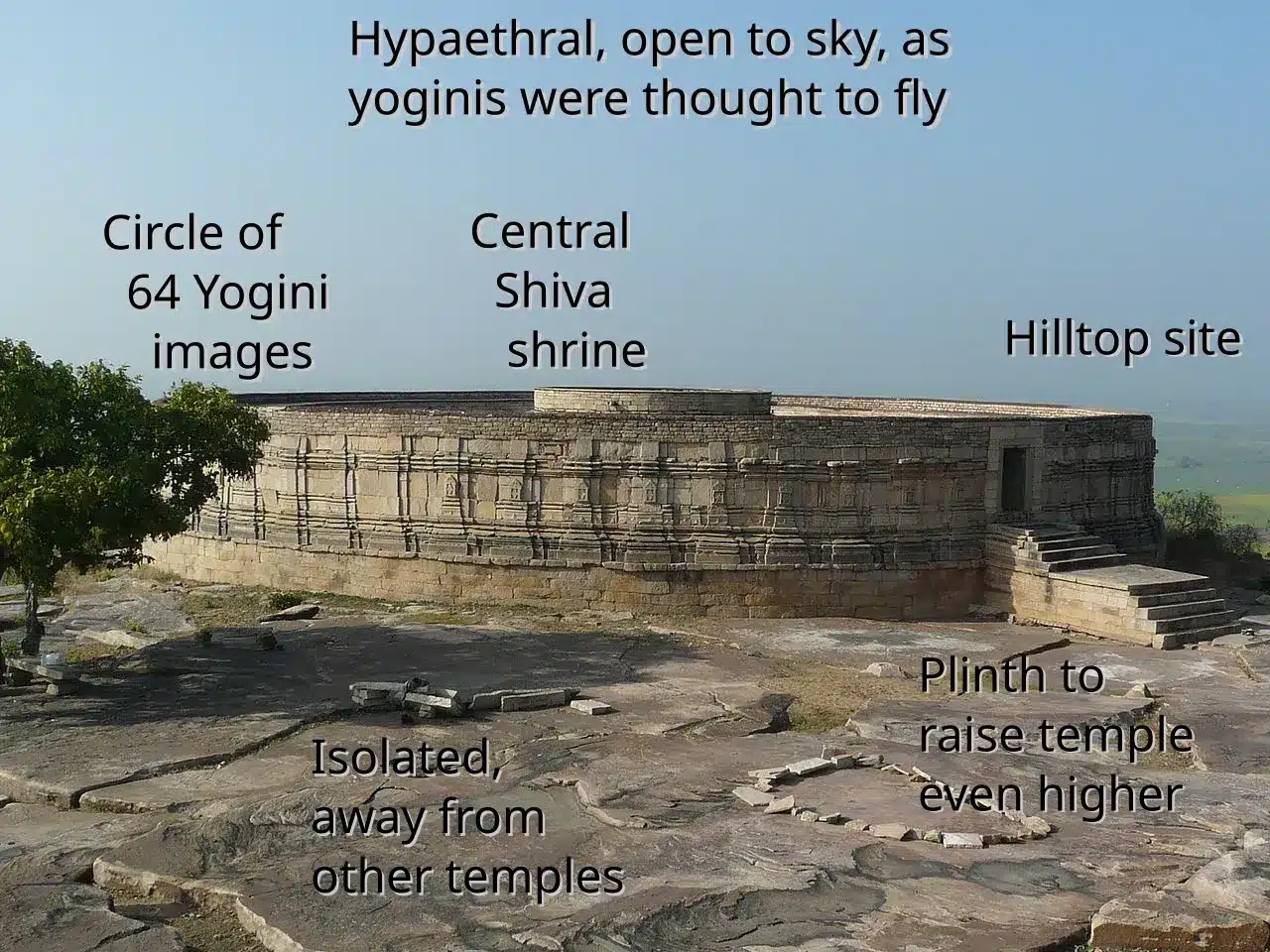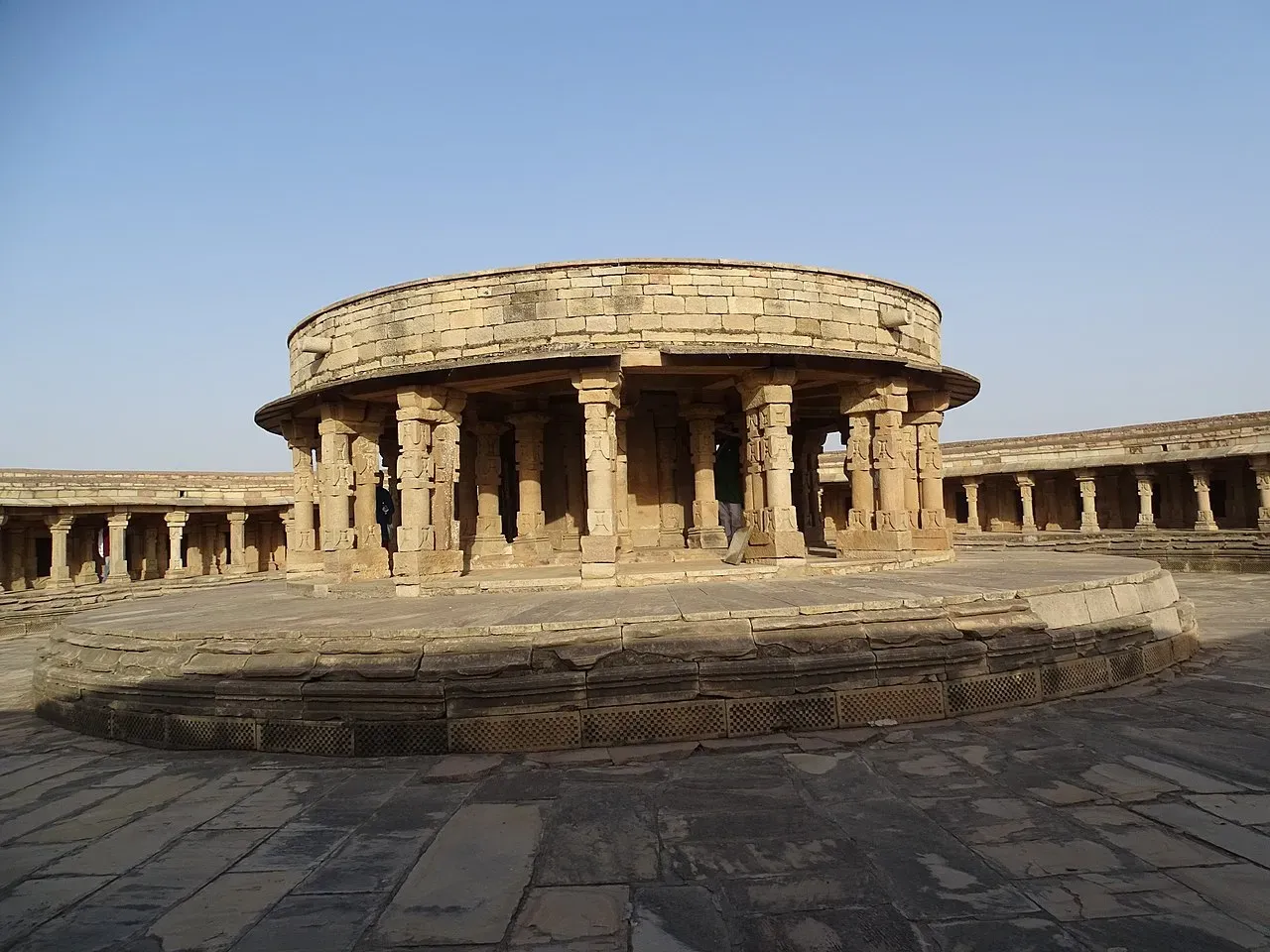Chausath Yogini Temple, an ancient shrine dedicated to 64 Yoginis, powerful feminine deities in Hinduism. Built between the 9th and 12th centuries by dynasties like the Chandelas, Kalachuris, Gurjara-Pratihara dynasty, and Imperial Cholas, these temples are mainly found in Madhya Pradesh, Uttar Pradesh, Odisha, and Tamil Nadu. Their circular, open-air structures reflect Tantric and Shaiva traditions. India has around 13 surviving Chausath Yogini temples, with eight located in Madhya Pradesh.
By the 13th century, the Yogini cult declined due to orthodox Hindu influences and invasions, yet their legacy endures in art, architecture, and spirituality. Today, these temples, including those in Khajuraho and Jabalpur, stand as enduring testaments to India's rich spiritual heritage, drawing historians, devotees, and researchers alike.
Chausath Yogini Temple Overview
Chausath Yogini temples, scattered across India, stand as fascinating monuments to ancient Tantric practices, reflecting the profound reverence for feminine power in Hinduism. The term "Chausath" refers to the number 64 in Hindi, and "Yogini" refers to a female yoga practitioner or, in this context, a powerful female deity.
- With 64 individual shrines dedicated to Yoginis (female practitioners of yoga or powerful goddesses) arranged in a circular or hypaethral design, these temples inspire both in their symbolism and their artistic complexity.
- These 64 Yoginis are regarded as divine forces and play a central role in Tantric worship. They are depicted as both alluring and threatening, representing a complex interplay of power, sensuality, and spirituality.
- The architectural and cultural significance of these temples provides valuable insight into medieval India's spiritual practices, women's role in religious contexts, and the deep connections between the natural world and divine forces.
Chausath Yogini Temple Architecture
Chausath Yogini temples are Indian temple architectural masterpieces dedicated to the 64 Yoginis, representing the dynamic interplay of divine feminine and masculine energies. Located on hilltops, these temples feature intricate design elements, with shrines and statues symbolizing cosmic energy, nature, and spiritual power.
- 64 Shrines for Yoginis: Each shrine houses an image or statue of a Yogini, often depicted with animal heads or theriomorphic features, reflecting their connection to nature, forests, and the Bhairava cult.
- The Yoginis are shown in dynamic dancing, meditative, or royal poses, symbolizing their diverse powers and aspects.
- Central Shrine: Typically houses the idol of Lord Shiva or Shakti, visible from each surrounding cell, representing the unity of the divine masculine and feminine energies.
- Central Courtyard: The courtyard is open-air, reinforcing the link with nature and the divine. Pillars surround the courtyard, often intricately carved, supporting the individual shrines.
- Structure: The temples are generally single-storey with a flat stone slab roof. The Stone load-bearing structures provide the temple's stability.
- Hilltop Locations: Temples are typically built on hilltops, symbolizing the connection between the earthly and divine realms.
Chausath Yogini Temple: Tantric Feminine Power
The cult of the Yoginis thrived between the 9th and 12th centuries CE, particularly within Tantric and Shaiva traditions. Tantric practices, including rituals, meditation, and specific postures, focused on channeling spiritual energies and invoking the Yoginis, regarded as guardians of secret knowledge. These deities were worshipped in esoteric rites by select practitioners.
Unlike the mainstream Hindu gods, the Yoginis embodied a more primal, earthy, and sensual aspect of the divine. This shift towards the feminine, along with the integration of Tantric rituals, marked a significant evolution in medieval Hinduism, where feminine energy was acknowledged as a vital force in the cosmic order.
Chausath Yogini Temple Location
There are around 13 Chausath Yogini temples in India, with 8 situated in Madhya Pradesh. These temples are dedicated to the 64 Yoginis, each representing a divine feminine power. The following are the locations most famous Chausath Yogini temples:
- Khajuraho, Chhatarpur district, Madhya Pradesh (M.P): Constructed in the late 9th century under the patronage of the Chandela dynasty. It is part of the world heritage site ensemble.
- The temple is situated on a stone outcrop to the southwest of Shiva-Sagar Lake and has a northeast orientation.
- Three sandstone sculptures of Brahmani, Mahishasurmardini, and Maheshwari found on site have been displayed in the Khajuraho Museum.
- Mitaoli, Morena district, (M.P): Also known as Ekattarso Mahadev Temple, was built in the 11th century under the patronage of the Gurjara-Pratihara dynasty. An inscription dated V.S. 1380 (A.D. 1323) credits its construction to Maharaja Devapala of the Kachchhapaghata dynasty.
- Located on a hilltop in Madhya Pradesh, this temple follows a unique circular design, with 64 subsidiary shrines surrounding a central sanctum.
- Originally dedicated to Devi, the temple now houses Shiva images in all its cells, emphasizing its connection to Shaivism.
- The circular layout of this temple is believed to have inspired the design of the Indian Parliament House.
- Bhedaghat, (M.P): Dates back to the 10th century. This circular stone temple holds immense historical, religious, and artistic significance during the Kalachuri dynasty.
- Badoh Bhedaghat, (M.P): It is composed of a rectangular shrine and a tall and massive shikhara, adjacent to some Jain temples.
- Hinglajgarh, (M.P): It is circular in design and was discovered during the clearance for the Gandhi Sagar dam.
- Over 500 sculptures were recovered, including fragmentary Yogini images and a Mahishasuramardini sculpture.
- Shahdol, (M.P): Known in ancient inscriptions as Sahasa-dollaka, has yielded a large collection of Yogini images that may be divided into two groups, one being a series of seated Yoginis and the other a set of standing images.
- Naresar, (M.P): Near Gwalior, is no longer standing, but 20 Yogini images, now in the Gwalior Museum, suggest its existence in the late 12th century. The site, a picturesque valley with Saiva temples, likely housed the Yogini shrine atop a hill overlooking an artificial tank.
- Lokhari, Uttar Pradesh Dating to the 10th century CE, is now in ruins, with 20 Yogini images and scattered stone blocks remaining. A goat-headed Yogini, stolen in the 1980s, was recovered from London and returned to India in 2022.
- Dudhai, Uttar Pradesh: Near Lalitpur, is a circular structure located on a remote mound in the Buri forest. Dating to the Chandela period, it was part of a once-flourishing temple complex near an artificial tank, similar to Khajuraho.
- Rikhiyan, Uttar Pradesh: It is now lost, but scattered architectural fragments suggest its existence in the early 10th century. Likely rectangular like Khajuraho, its Yogini sculptures show affinities with Orissan temple art.
- Kanchipuram, Kaveripakkam, Tamil Nadu: Dates to the Imperial Cholas period (c. 900 AD), with several recovered Yogini images now housed in museums worldwide. Many sculptures were found in an artificial lake at Kaveripakkam, likely originating from nearby temples.
- Hirapur, Odisha: It is the smallest of its kind, measuring 30 feet in diameter with 8-foot-high stone walls. Built by Queen Hira of the Bhaumakara dynasty (8th century CE), it features exquisitely sculpted Yoginis and is dated to the late 9th or early 10th century.
- Ranipur Jharial, Balangir district, Odisha: It is a circular shrine atop a rocky outcrop, near a large natural tank that was a major pilgrimage site over a thousand years ago. The area also contains small stone temples, a large brick temple, and Buddhist remains.
Chausath Yogini Temple Legacy
The Yogini cult began to decline by the 13th century due to the rise of orthodox Hindu practices and Islamic invasions. However, its influence persists in Indian art, architecture, and spirituality. Chausath Yogini temples stand as lasting symbols of the feminine divine, showcasing a time when both male and female deities were equally revered.
Today, these temples are valued for their spiritual and archaeological significance. Sites like Khajuraho and Bhedaghat attract visitors for their historical and architectural beauty. They continue to inspire Tantric practitioners and feminists, symbolizing feminine power, sensuality, and spirituality.
Chausath Yogini Temple UPSC PYQs
Q1. With reference to Chausath Yogini Temple situated near Morena, consider the following statements: ( UPSC Prelims 2021)
- It is a circular temple built during the reign of the Kachchhapaghata Dynasty.
- It is the only circular temple built in India.
- It was meant to promote the Vaishnava cult in the region.
- Its design has given rise to a popular belief that it was the inspiration behind the Indian Parliament building.
Which of the statements given above are correct?
(a) 1 and 2
(b) 2 and 3 only
(c) 1 and 4
(d) 2, 3 and 4
Ans: (c)
Last updated on December, 2025
→ Check out the latest UPSC Syllabus 2026 here.
→ Join Vajiram & Ravi’s Interview Guidance Programme for expert help to crack your final UPSC stage.
→ UPSC Mains Result 2025 is now out.
→ UPSC Notification 2026 is scheduled to be released on January 14, 2026.
→ UPSC Calendar 2026 is released on 15th May, 2025.
→ The UPSC Vacancy 2025 were released 1129, out of which 979 were for UPSC CSE and remaining 150 are for UPSC IFoS.
→ UPSC Prelims 2026 will be conducted on 24th May, 2026 & UPSC Mains 2026 will be conducted on 21st August 2026.
→ The UPSC Selection Process is of 3 stages-Prelims, Mains and Interview.
→ UPSC Result 2024 is released with latest UPSC Marksheet 2024. Check Now!
→ UPSC Prelims Result 2025 is out now for the CSE held on 25 May 2025.
→ UPSC Toppers List 2024 is released now. Shakti Dubey is UPSC AIR 1 2024 Topper.
→ UPSC Prelims Question Paper 2025 and Unofficial Prelims Answer Key 2025 are available now.
→ UPSC Mains Question Paper 2025 is out for Essay, GS 1, 2, 3 & GS 4.
→ UPSC Mains Indian Language Question Paper 2025 is now out.
→ UPSC Mains Optional Question Paper 2025 is now out.
→ Also check Best IAS Coaching in Delhi
Chausath Yogini Temple FAQs
Q1. What is the secret of Chausath Yogini Temple?+
Q2. Who constructed the Chausath Yogini Temple of Jabalpur?+
Q3. Which God is the Chausath Yogini Temple?+
Q4. Which religion does the Chausath Yogini Temple promote?+
Q5. What is a female Tantric called?+
Tags: art and culture upsc notes chausath yogini temple chausath yogini temples quest



















